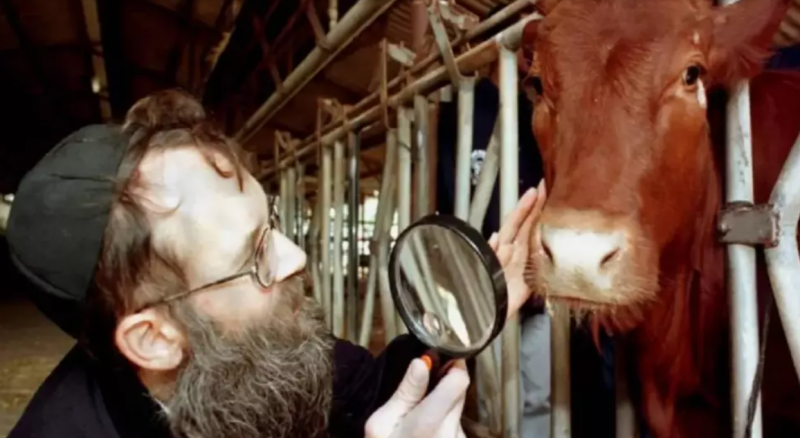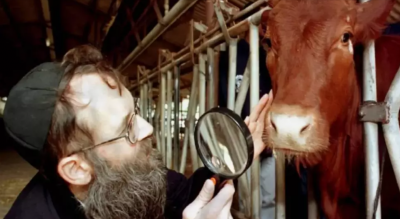In one of his speeches, Abu Ubaida, spokesperson for the Izz ad-Din al-Qassam Brigades, the military wing of Hamas, mentioned that red heifers in Israel are now ready. This reference stems from a news report published last July about the most extremist Israeli government importing five red heifers from Texas, signaling the beginning of the process to build the Third Temple over the ruins of Al-Aqsa Mosque, as dictated by biblical teachings. So, what is the story of these red heifers? What is their relation to the "Flood of Al-Aqsa"? What conditions do Jewish texts stipulate for their selection? And what are the implications of these religious rituals amid the rise of religious Zionism in Israel and the increasing preparations to build the alleged temple?
### The Origin of the Tale
In both Judaism and Evangelical Christianity, red heifers appear in narratives of the "End Times." While the birth of the pure red heifer and its sacrifice prior to the construction of the Third Temple is a significant belief in mainstream Orthodox Judaism, its appearance according to Evangelical belief heralds the end of times and the return of Christ to earth. For both groups, certain requirements must be met for this time to come, primarily: the restoration of the State of Israel, transforming Jerusalem back into a Jewish city—which Israel partially achieved in 1967—and the birth of a red heifer in the Land of Israel for Jews to construct their temple for the third time.
Jews claim that no red heifer with the required specifications has been born for more than 2000 years, according to the British "Mirror." According to Rabbi Chaim Richman, an expert on the red heifer and director of the Temple Institute, there is a tradition that throughout history, nine complete red heifers have been used for purification, and the appearance of the tenth red heifer is linked to the coming Messianic age and the rebuilding of the temple.
### Religious Roots
Jewish law stipulates that a heifer, referred to in Hebrew as "Parah Adumah," must have pure red hair, with no more than two hairs of any other color. It must be born naturally and raised in the Land of Israel, as well as never having been pregnant or milked. Once all conditions are met and the heifer reaches the age of two, it becomes suitable for use in the "purification" process on the Mount of Olives in Jerusalem, across from the Al-Aqsa Mosque, where it is slaughtered and burned according to specific conditions. The ashes mixed with pure water are then used to purify Jews and the place where the temple will be built. God does not permit construction and worship in the temple without restoring ritual purity, which can only be achieved using the ashes of the red heifer.
According to Jewish tradition, the ashes of the red heifer are believed to have the power to purify individuals and even the holy lands where the Third Temple is expected to be built. These conditions are mentioned in the Book of Numbers, one of the sacred texts of the Jewish Torah, which prohibits Jews from entering the Al-Aqsa Mosque without achieving sacred purity.
Arab Jerusalem newspaper reported on the hesitance regarding setting a date for the slaughter rituals, quoting Ma'ruf al-Rifai, spokesperson for the Jerusalem Governorate and advisor to the governor for media affairs. Al-Rifai explained that Rabbi Azaria Ariel, son of Yisrael Tzri'el, founder of the Temple Institute, stated that it has not yet been definitively confirmed that these heifers are religiously fit for starting practical steps, and monitoring is still ongoing.
The newspaper attributed to Rabbi Azaria that the "redness" of the heifers is better than it was about a year ago, indicating that the shock the heifers experienced during their air transport to Israel, coupled with the differing climatic conditions between America and Israel, may have contributed. He added that these heifers undergo a hair change every six months, meaning there is an additional opportunity to cover them in red hair again, and that at least 12 months of discussions and monitoring are necessary before proceeding to practical phases.
Additionally, he mentioned that those in charge of this project have not yet discussed the specific location on the Mount of Olives for the red heifer's slaughter, or whether it is necessary to do so in a straight line towards the east. This matter is important, and answering it could help overcome some obstacles. He noted that the best location remains the site of the Church of the Pater Noster on the western slope of the Mount of Olives.




